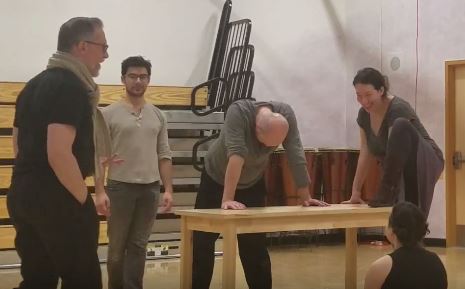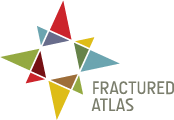People regularly question me about what it’s like to be an Akropolis actor. We talk about ourselves as an actor-centered, process-drive ensemble committed to long-form rehearsal, so what does that look like in practical terms? Aside from the value we place on physical and vocal training, how do we approach the creative process in the rehearsal studio, and what expectations do we have for our actors that differ from those of an actor engaged in the typical process of putting up a show in 4 or 5 weeks. As we near the opening of Crime + Punishment after more than 550 group rehearsal hours I thought it would be an interesting opportunity to share those expectations with you. I’d love to receive your responses and answer any questions.
Working as an APL Ensemble Actor

December 2016 rehearsal of Crime + Punishment (Joseph Lavy, Matt Sherrill, Tyler Polumsky, Emily Jo Testa, Annie Paladino)
Working as an APL ensemble actor means:
- Embracing APL’s signature aesthetic, which:
- asserts that the theatrical life of an APL production arises from the tension created between formal discipline and inter-personal immediacy
- demands levels of specificity and concepts of spontaneity which may at times seem at odds with dominant contemporary acting approaches
- Engaging each rehearsal as a generative artist, making propositions through prepared actions, etudes, improvisations for theatrical material from which the performance text will be created
- Recognizing that every proposition—however formal, realistic, or abstract—must be built on a foundation of impulses and points-of-contact with stimuli from external sources (living partners, objects, memories and associations projected outside of the self)
- Proposing performative material that is precise, repeatable and iterative
- Adapting one’s proposition to changing circumstances (montage with other actors, inclusion of music and/or text, addition of objects, changes of space) without abandoning or destroying the proposition’s originating stream-of-life
- Incorporating, retaining, and justifying adjustments made to the proposition in collaboration with the director and any acting partners
- Remaining receptive and sensitive to new meanings as they emerge, and embodying them in subsequent iterations
- Developing alternate propositions for a subject or scene when inspired or requested, rather than radically changing or abandoning an existing proposition without discussion or collaboration with the director and acting partners
- Elaborating with one’s artistic partners the overall performance text composed of acting scores with compound dramaturgical levels:
- The original truth, associations and details of the initial propositions
- Specificity of form and points-of-contact with acting partners
- A living give-and-take with acting partners, which respects and maintains the established physical structure
- Precise execution which ensures clear communication of intended information to the spectator
- Using one’s acting score as the means to provoke and respond to one’s acting partners and spectators, not simply as a form of choreography or an illustration of a text
- Respecting the established details of the final performance text as elaborated through the rehearsal process, and not introducing significant deviations from their score in a moment of on-stage inspiration or improvisation in performance conditions. Once a production is in performance, new propositions are first to be explored and validated in collaboration with the director and other actors under rehearsal conditions before being introduced before an audience



